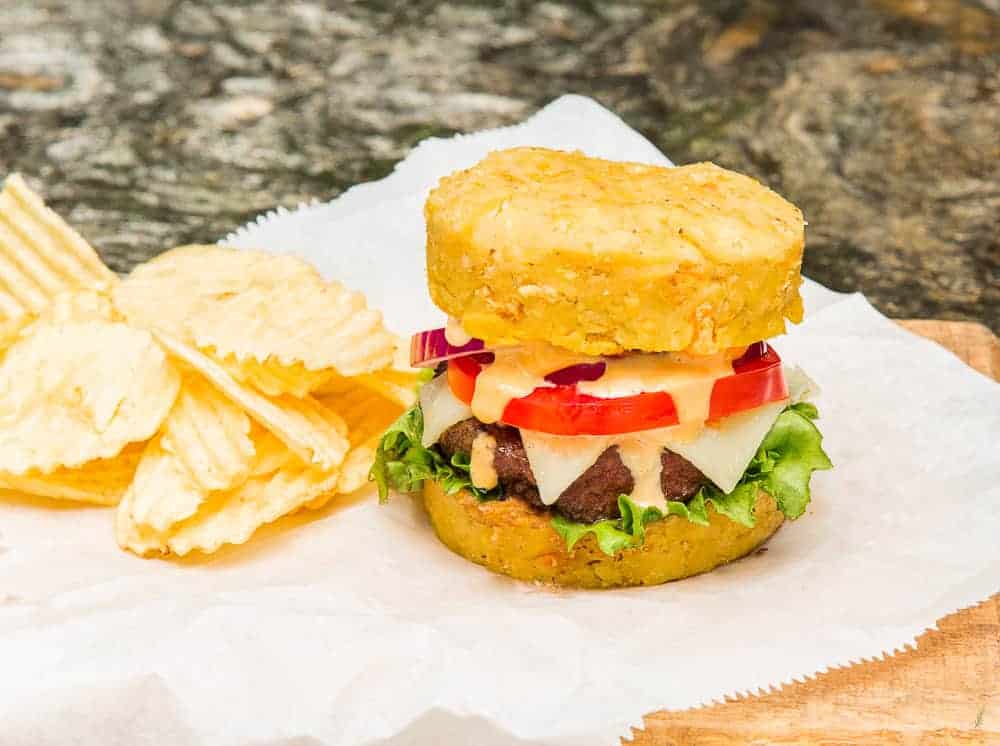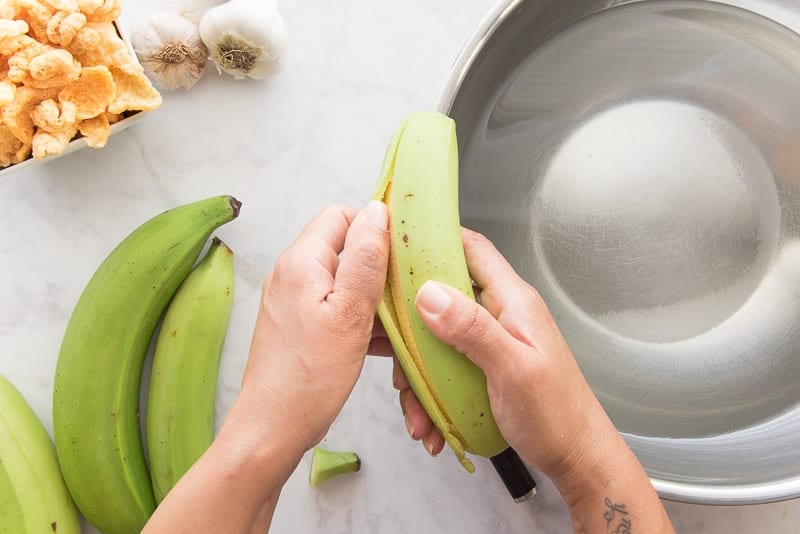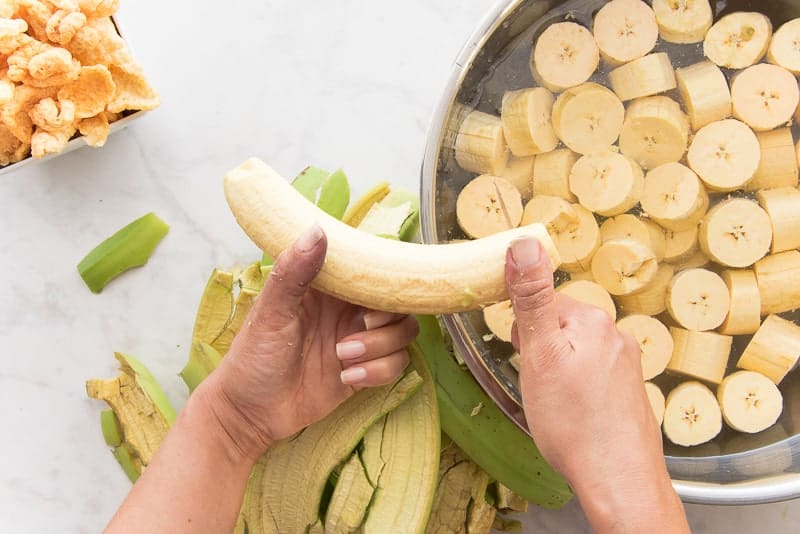
What are Mofongo Burgers?
If you’ve never had the pleasure of tasting mofongo, you’re in for a treat. Instead of burger buns, we’re using these garlic and pork rind-laced mashed plantains to create the platform for our burgers. Basically, mofongo burgers are a mash-up of the Puerto Rican dish mofongo and the North American favorite: burgers. Probably a GI or tourist went to PR, brought the burgers to the island, and complained they wanted a burger instead of that “ethnic food”. Burgers are a part of the Puerto Rican fast food culture now as much as they are here in the States. Much like the rest of the world, burgers take on a whole new flair on the isle of Borinquen.
In short, mofongo burgers are proof that two cultures can combine to create something amazing. Which is clearly something my parents already knew when they created me. They said you’re welcome.
What is Mofongo?
Mofongo has no English translation. It is a recipe that came from the African ancestry Puerto Ricans share. Most likely African fufu, or mashed plantain and yuca, is the precursor to our mofongo.
Made with very green plantains, garlic paste, and pork cracklings, mofongo is often eaten in tandem with a saucy protein. My family prefers our mofongo with seafood in garlic sauce or with fried pork chunks. The island boasts tons of “mofongo con ______” recipes, and each region has one they’re known for. We’ve even gone so far as to stuff our Thanksgiving turkeys with the stuff. Mofongo is a mix of creamy, savory, and garlicky in all the most positive ways a dish can be.
As a burger bun, it’s all of those things and more. Need a gluten-free option for your diet? This is it. Want to avoid eating another boring burger? I’ve got you!
What ingredients are used to make Mofongo Burgers?
Mofongo is not a complicated Puerto Rican recipe. You only need very green plantains, pork rinds, and fresh garlic. That’s it and that’s all. Things get a bit more unique if you’re making the mofongo into burger buns, though. You want a bun that will hold together somewhat, so a small amount of chicken or pork stock is added to bind the mixture together better. The amount of stock you use is minimal though.
Burger patties, of course, are the main ingredient. Your average, run-of-the-mill patty will work. The patties are seasoned with adobo before grilling. Your preferred toppings adorn the burger: onions, lettuce, tomato, and cheese are our favorites. Finally, a sauce that mashes all the condiments in one is slathered onto the bun and we’re ready to eat.
Because mofongo burgers are, let’s say, “robust,” they will easily turn into a knife and fork situation. I’ll explain how I make mine “eat-with-hand” friendly later. Let’s make some burgers!
What kind of plantains are used to make Mofongo?
Green, green, green!! Honestly, I think my husband thinks I’m obsessive about how green my plantains have to be. Whenever I make mofongo, I go on this tirade about how, “None of these stores know what a ripe plátano (plantain) is.” Even our local Hispanic market fails to stock truly green plantains. It drives me absolutely bonkers. But, it’s important to use super green plantains which have no trace of sweetness. Green plantains also fry up crisper than yellowing plantains do. True connoisseurs of mofongo will taste a yellowed plantain in theirs a mile away.
Don’t mistake green bananas for plantains. The green banana is smaller and thinner than plantains are. In addition, they are sold in bunches, whereas plantains are sold individually. Green bananas have a different texture and don’t taste the same, so they won’t really do much in this recipe.
Find the greenest plantains you can and plan to use 1 1/2 per burger you plan to make.
How do I peel a plantain?
The hardest part of this recipe is peeling the plantains. Plantains are notoriously laborious to peel. So much so, I’ve pulled the flesh of my fingers away from their nail bed after being a bit too aggressive with the process. The key is to be patient and methodical when peeling the plantain.
Use a paring knife to cut both ends from the plantain. Cut a slit down the back of the plantain, then use the tip of the knife’s blade to loosen the skin on either side of the split. Now, take the meaty part of the tip of your thumb and push up on the peel. As you push, move down the length of the plantain, loosening the peel from the fruit.
How do I keep plantains from staining and turning brown?
The stains left behind on one’s clothing or skin have become a source of pride for Puerto Ricans, so just embrace it (or wear gloves). La Mancha de Plátano is a poem that speaks of the pride a jíbaro (country person) has of being a Puerto Rican who works with the land and his hands. The stains are ruthless and difficult to remove. Check out my thumbs if you don’t believe me. As a result, I advise you not to put the plantains on anything you value.
Since plantains are bananas, they tend to turn brown when exposed to air. To avoid that, simply cut them straight into a large bowl that’s been filled with salted water. Not only does the salted water keep the plantains from going brown, it seasons them, too.
How long do I fry the plantains?
Because we fry the plantains in oil, we must dry them thoroughly before doing so. Since oil and water are a dangerous combo, I first drain the soaked plantains before blotting them dry with a clean towel. Once I’m sure the plantains are bone dry, I cover them with a towel to keep them from being exposed to too much air.
Heat frying oil (vegetable or peanut oil) to 350°F in a large dutch oven. Add 15-20 slices of plantains to the hot oil and fry them for 4-5 minutes. A knife should pass through the fried plantains and meet no resistance. After the plantains are tender on the inside, use a spider to strain most of the oil from them before transferring them to a bowl. Unlike my other frying recipes, this time I don’t want you to soak up the oil from the plantain pieces. That oil, along with any stock we may use, will help keep the mofongo moist.
Continue to fry the plantains until they are all cooked.
What’s the best way to mash plantains for Mofongo Burgers?
Release some pent-up aggression now that you’ve fried the plantains!
Add 8 chunks of plantain to a pilón (or a mortar and pestle), followed by a handful of pork rinds, some garlic paste and the oregano leaves. Mash like crazy until the plantains look like mashed potatoes. Add 8 more chunks of plantains and mash again. The mixture will look like a bowl of mashed potatoes with flecks of pork rind throughout.
By the way, it’s important to use crisp pork rinds. I find that the store brand rinds that don’t have thick pieces of hard fat are best. When in doubt, Baken-et Pork Rinds are perfect. The others don’t break down as well and leave large, rubbery chunks of chicharrón (pork skin) in the mofongo.
As you can see, you will need to mash the plantains in stages, unless you have an obscenely large pilón.
How do I form the “buns” for Mofongo Burgers?
After you mash your plantains and created the mofongo, squeeze a handful of the mix together. If it feels pasty and holds together,you’re good to form them into the buns. If they feel dry and crumble apart after you release pressure, you can add a little stock to encourage it to hold together.
Use a large spoon to scoop half of the mixture out of the pilón and into the center of a lightly-greased round cookie cutter. Then, use your fingers to firmly press the mofongo into the form. You want to make sure the mofongo holds together after unmolding. I go a further step and press the sides down to mimic the dome of a regular bun. That’s totally not a must, though. For the bottom half of the bun, just press the remaining mofongo the same way, just make this half very flat. This is the bottom “bun”.
I form my mofongo buns on a sheet pan that I lightly grease with olive oil. It helps to keep the buns from sticking and I can keep them warm in the oven- covered in foil- while I grill the burgers.
What kind of sauce goes on a Mofongo Burger?
While the traditional burger condiments totally work on mofongo burgers, I prefer a concoction called mayo-kechu-mosta, which is totally not a real thing. I made it up just now.
All it is is a spread made from mayonnaise, ketchup, mustard, Adobo, and fresh garlic. My other name sounds much cooler, though, doesn’t it?
Just mix all of the ingredients together until combined. You can make this up to two weeks ahead of time and store it in the fridge. It goes well as a condiment for most things, but I especially love to dip my tostones or fries in it.
What kind of burger patties should I use for the Mofongo Burgers?
All that’s left is to grill the burgers. I prefer burgers that are 85% lean with 15% fat throughout. Look for packages that read 85/15 in the stores to make it easy. Choose whichever grind you like and season the patties liberally (on both sides) with more adobo.
Heat a charcoal grill using your preferred method to medium-high heat (or a gas grill to 450°F). Press your burgers flat and leave a dimple in the center to ensure you grill up nice flat burgers. Grill the burgers for a total of 5 minutes (medium-rare); flip them over after the first 2 1/2 minutes of grilling.
Remove the burgers from the grill and leave them to rest for 5 minutes. I start setting up my mofongo and toppings while I wait for them to rest.
What kind of toppings should I use?
I keep it classic with lettuce, tomatoes, purple onions, and cheese. Slather the mayo-kechu-mosta onto one, or both, sides of the mofongo buns. That’s totally your call. Bacon, sauteed mushrooms, or grilled onions: all great additions, as well.
Place the rested burgers on the prepared mofongo buns and you are ready to serve! To avoid that mess of a bite when it’s time to eat your mofongo burgers, I suggest cutting them into quarters. It makes picking them up and biting into them easier. Or just eat them with a knife and fork.
How long can I store Mofongo?
Store mofongo for a couple of days in the fridge. You definitely need to add stock since the longer it sits, the drier it becomes. Reheat mofongo in the microwave for 1-2 minutes after adding the stock. The burgers, however, I really wouldn’t store and reheat. They just don’t taste the same.
So, there’s my contribution to the summer meal! I hope you enjoy this Puerto Rican-U.S. mash-up and share it with your friends and family. Be sure to pin it to your food boards, too!

Mofongo Burgers
at Sense & EdibilityEquipment
- mortar and pestle
- grill
- circular form
Ingredients
For the Burger Spread (make up to two weeks ahead)
- 1/4 cup mayonnaise
- 2 tablespoons ketchup
- 1 tablespoon mustard
- 1 clove garlic crushed
- 1/4 teaspoon adobo
For the Mofongo Buns
- 6 plantains very green, peeled and cut into 1 1/2" chunks
- water salted, for soaking
- 8 ounce bag pork rinds
- 12 cloves garlic mashed to a paste
- 2 teaspoons dried oregano leaves
- vegetable oil for frying
- chicken stock as needed (optional)
For the Burgers
- 4 burger patties (85/15 or 80/20)
- 1 1/2 teaspoons adobo or to taste
- 4 slices swiss cheese
- lettuce
- tomatoes slice
- purple onions sliced
Instructions
Make the Burger Spread
- In a small mixing bowl, stir together the mayonnaise, ketchup, mustard, garlic, and Adobo until combined. Store the spread, covered, in the refrigerator until used.
Cook and Mash the Plantains
- Soak the sliced plantains in a large bowl for 10 minutes of salted water(6 cups of water with 1/4 cup of salt) for 10 minutes to season them.
- While the plantains are soaking, heat the frying oil in a 5qt dutch oven to 350°F. Once the oil is near the proper temperature, drain the soaked plantains before blotting them dry with a clean towel. When the plantains are bone-dry, cover them with a towel to keep them from being exposed to too much air while you begin frying them.
- Add 15-20 slices of plantains to the hot oil and fry them for 4-5 minutes. When done, a knife should pass through the fried plantains easily and meet no resistance.
- After the plantains are fried, use a spider to strain most of the oil from them before transferring them to a bowl. Don't worry about removing excess oil from the plantain pieces. The oil, along with any stock you may use, will help keep the mofongo moist.Continue to fry the plantains until they are all cooked.
- Add 8 chunks of plantain to a pilón (or a mortar and pestle), followed by a handful (about 1/2 cup) of pork rinds, 1 teaspoon of garlic paste, and 1/2 teaspoon of oregano leaves. Mash the plantains until they resemble mashed potatoes. Add 8 more chunks of plantains and mash again. The mixture will look like a bowl of mashed potatoes with flecks of pork rind throughout.
- You will need to mash the plantains in stages, unless you have an obscenely large pilón. After you mash your plantains and created the mofongo, squeeze a handful of the mix together. If it feels pasty and holds together, you can begin forming the the buns. If the mofongo feels dry and crumbles apart after you release pressure, add a tablespoon of stock and remix to encourage it to hold together.
Prepare the Mofongo Buns
- Use a large spoon to scoop half of the mixture out of the pilón and into the center of a lightly-greased round cookie cutter. Create the bottom "bun" by firmly pressing the mofongo into the mold, make this half very flat. Carefully press the mofongo onto a lightly greased sheet tray.
- Spoon the remaining mofongo into the form. Press the sides down slightly to mimic the dome of a regular bun. This is a good way to differentiate the tops from the bottom. Continue mashing and forming the mofongo buns until you have four tops and four bottoms. Cover the pan lightly with foil and transfer the pan to a warm (170°F) oven while you grill the burgers.
Grill and Assemble the Mofongo Burgers
- Heat a charcoal grill using your preferred method to medium-high heat (or a gas grill to 450°F).
- Press the burgers flat, leaving a dimple in the center to ensure the burgers grill as flat as possible. Season both sides of the patties with a generous pinch of adobo.
- Grill the burgers for 2 1/2 minutes, then use a spatula to flip them over and grill for an additional 2 1/2 minutes: for a total of 5 minutes (for medium-rare burgers). Grill 2-3 minutes longer for medium-well or well-done burgers. Remove the burgers from the grill and allow them to rest for 5 minutes.
- Remove the pan of mofongo buns from the oven and remove them from the pan using a spatula. Layer the cheese, lettuce, tomatoes, purple onions, and slather on a generous amount of burger spread on the inside of the top mofongo bun.
- Place the rested burgers on the prepared mofongo buns and you are ready to serve! To avoid a big mess when eating, I suggest cutting the mofongo burgers into quarters, or just eat them with a knife and fork.

















I use a lot of plantains in every stage in my cooking and recipes as well. I have never made mfongo, though I know of it so I am happy to see how you have laid it out very well here Marta! Like you, when I am buying green, I am buying GREEN!
Yes, green is definitely the way to go when it comes to platano verde!
That was so interesting to read! Who knew about the green plantains vs. yellow plantains? Or where the mofongo came from? Thank you for sharin! These burgers look absolutely delicious, what a great change for once!
My pleasure!!
This recipe looks super tasty and makes such cool use of plantains. Can’t wait to try making this one!
Enjoy them, Moop!
Wow! I’ve never tried mofongo burgers before but they look absolutely delicious! Plus, I LOVE plaintains!
You’re going to love this one, Veronika!